Macro Monthly Time for Chinese growth to drive global markets
Last month, the multi-asset strategy team outlined three key questions that would inform cross-asset performance for the rest of 2023. In light of recent events, they explore three additional questions.
Highlights
Highlights
- China’s reopening is on track, and this remains a key tailwind for the global economy in 2023.
- Recent geopolitical tensions alongside strength in US activity, labor market, and inflation data early in 2023 have sparked a rally in the US dollar and weighed on China-sensitive assets.
- In our view, the next leg of the mini reacceleration in global activity will be driven by China.
- We prefer positions that are linked to China’s rebounding economy, such as emerging market equities over developed market stocks, cyclical sectors like energy, and value stocks over growth.
The most important new tailwind for global growth in 2023 – a durable, comprehensive economic reopening in China – has been undermined in February amid a reemergence of geopolitical strife and a counter-trend rally in the US dollar. In our view, the pullback across many China-sensitive areas of financial markets marks consolidation on the heels of strong gains and is an opportunity to position for a renewed push higher.
Our belief is that President Xi Jinping will largely be able to achieve the policy goals he sets. Over the past few years, this meant maintaining zero-COVID-19 policies and addressing perceived excesses in the real estate and technology/internet platform sectors. Now, it means reestablishing a solid foundation for Chinese growth.
Our portfolios are positioned to benefit from a strong rebound in Chinese activity and resilience in developed market growth. We prefer emerging market equities – in particular, China – to US stocks; cyclical sectors, especially energy, vs. more defensive or acyclical segments of the market; and value stocks over growth.
Recovery on track
Recovery on track
China’s pro-growth policy changes are bearing fruit. High-profile official economic data are likely to take some time to testify to the robustness of China’s recovery, because of the lags involved. But more timely high-frequency data already suggest that a durable economic reopening is well underway.
Road traffic, as measured by congestion levels in China’s 15 largest cities, is running at levels not seen since September 2021. Other measures of travel intensity within Chinese cities tell a similar story of enhanced mobility. The strength in demand has been sufficient for Saudi Arabia to raise selling prices to Asia. In addition, Chinese refiners are also on pace to source about twice as much crude this March from the US Gulf Coast compared to the past few years. Refinery utilization rates, particularly for state-owned firms, have been picking up steam to meet this increased appetite. We believe it is only a matter of time until this sequential improvement in demand from both China and developed markets heading into the spring and summer produces more upside in oil prices as the seasonal slow period passes.
Chinese new home prices were steady in January, arresting a 16-month streak of monthly declines. The suite of policy measures designed to improve the supply side, and to a lesser extent, bolster demand, suggest that this important sector should find more stability in 2023 vs. 2022.
One lesson from developed market economies in 2021 is that markets may consistently underestimate the momentum generated by the reopening process. We think that mistake is being made again with regards to China. 12-month forward earnings estimates for Chinese stocks are near levels that prevailed at their 2020 lows. So too are forward price-to-earnings ratios. We believe there is ample scope for Chinese equities to both post surprisingly strong earnings and to re-rate higher in line with emerging market stocks more broadly. In addition, multiples on very expensive US stocks should narrow towards EM equity valuations, amid high rates and earnings headed in the other direction.
We will continue to closely monitor a number of metrics including Chinese mobility (car, subway, and flight utilization), consumer spending, employment data, and oil imports to confirm that its economic rebound continues to gain traction.

Related
Macro updates
Macro updates
Keeping you up-to-date with markets
Exhibit 1: Chinese mobility off to a strong start in 2023
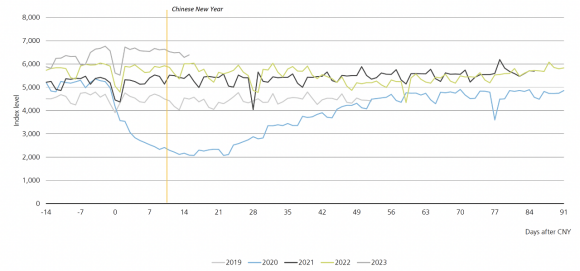
Exhibit 2: Chinese economic data exceeding expectations by more than US, world
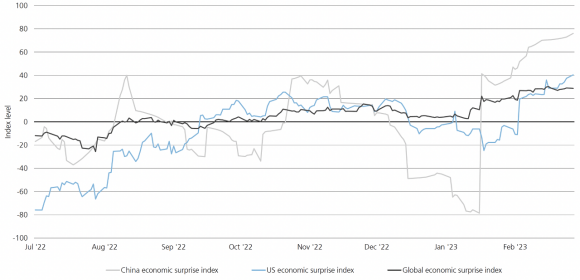
Negative catalysts fading
Negative catalysts fading
In our view, the factors that interrupted the outperformance of Chinese equities – a resurgent US dollar and geopolitical concerns – will not have much more staying power.
We came into the year with high conviction that calls for an imminent US recession were far too pessimistic. Indeed, US activity and inflation data have started off the year surprisingly strong relative to consensus. This has caused the market’s expectation for the Federal Reserve’s terminal policy to break to the upside after being in a narrow four-month range around 5 percent. (See Exhibit 4). A higher expected terminal rate, along with an unwind of short positioning, has sparked a sharp surge in the US dollar in recent weeks. Dollar strength is typically a headwind to cyclical positions, and especially emerging market equities. This episode has been no exception.
However, even some of the more hawkish Federal Reserve officials who would have preferred to raise rates by 50 basis points in February are reluctant to revise their estimate for the eventual end point for the central bank’s policy rate upwards as of now. We (and they) believe that the US economy is neither as sluggish as December’s data made it out to be, nor in full-blown boom mode as some of the January figures would imply. The truth is probably somewhere in between. It is likely that US economic data still points to a solid expansion in February, but with a step-down in momentum.
Geopolitics have also played a key role in fueling risk aversion for Chinese stocks. The MSCI China Index erased all of its multiple expansion from January after news regarding the entrance of a Chinese spy balloon over US territory. As that issue subsided somewhat, concerns over China’s potential military support for Russia emerged.
In our view, some statements made by US officials are more noise than signal, aiming to deter China from providing military aid to Russia and diminish China’s attempt to position itself as an independent arbiter of a peace process to resolve the war instigated by its ally. Importantly, dialogue between the US and China remains open, with plans for US President Joe Biden and Xi to speak “in the not too distant future,” according to the US National Security Advisor. As mentioned, we have received many signals that Chinese policy has shifted towards prioritizing economic growth. We do not think President Xi plans on compromising that goal by drawing the ire of the US and Europe alike by providing weapons to Russia. Such a course of action would likely see the US and Europe enact crippling sanctions that, in our view, would undo the economic progress China has made to date.
Exhibit 3: Earnings, multiples for Chinese equities have room to run higher
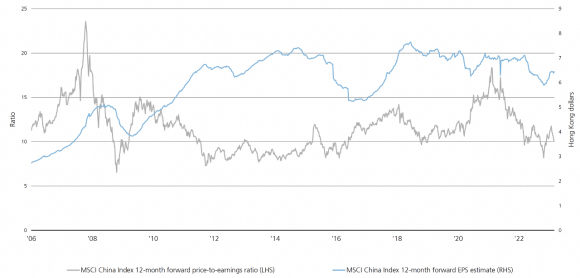
Exhibit 4: Higher expectations for the Fed's peak policy rate have helped the US dollar
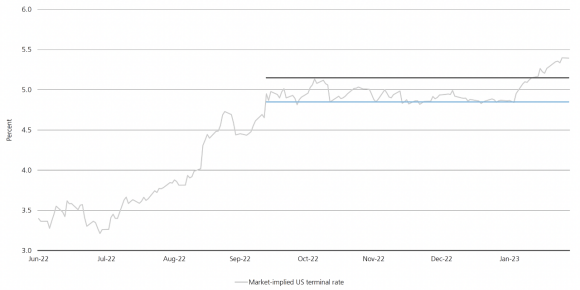
Asset allocation
Asset allocation
We believe 2023 marks China’s return to being a leader rather than laggard in economic growth. This dynamic, in our view, will prove a more potent catalyst for markets than recent geopolitical disputes or the ultimate peak for the Federal Reserve’s policy rate.
We do not expect US activity and inflation data to be so strong as to provoke a return to 2022 in rates and foreign exchange markets, where expectations for the Fed’s policy rate – and the US dollar vs. other currencies – trended persistently higher. The next leg of the mini reacceleration in global activity will be driven by China – and benefit the assets most sensitive to its economic rebound.
The China growth story, coupled with clear evidence that developed market economies will avoid recession for at least the first half of the year, is key to our preference for cyclical assets, for example: emerging market equities over US stocks, sectors like energy and financials, and value stocks over growth.
Asset class attractiveness (ACA)
Asset class attractiveness (ACA)
The chart below shows the views of our Asset Allocation team on overall asset class attractiveness as of February 28, 2023. The colored squares on the left provide our overall signal for global equities, rates, and credit. The rest of the ratings pertain to the relative attractiveness of certain regions within the asset classes of equities, rates, credit and currencies. Because the ACA does not include all asset classes, the net overall signal may be somewhat negative or positive.
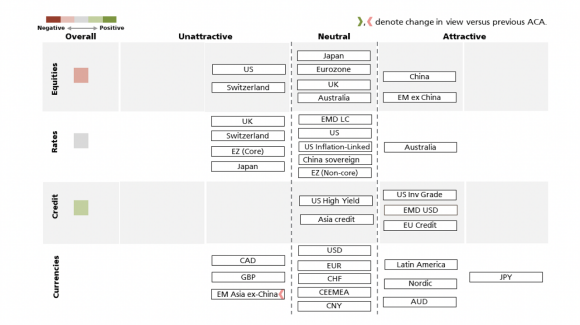
Asset Class | Asset Class | Overall/ relative signal | Overall/ relative signal | UBS Asset Management’s viewpoint | UBS Asset Management’s viewpoint |
|---|---|---|---|---|---|
Asset Class | Global Equities
| Overall/ relative signal | Light red | UBS Asset Management’s viewpoint |
|
Asset Class | US Equities | Overall/ relative signal | Light red | UBS Asset Management’s viewpoint |
|
Asset Class | Ex-US Developed market Equities | Overall/ relative signal | Grey | UBS Asset Management’s viewpoint |
|
Asset Class | Emerging Markets (EM) Equities | Overall/ relative signal | Light Green | UBS Asset Management’s viewpoint |
|
Asset Class | China Equities | Overall/ relative signal | Light Green | UBS Asset Management’s viewpoint |
|
Asset Class | Global Duration | Overall/ relative signal | Grey | UBS Asset Management’s viewpoint |
|
Asset Class | US Bonds | Overall/ relative signal | Grey | UBS Asset Management’s viewpoint |
|
Asset Class | Ex-US | Overall/ relative signal | Light red | UBS Asset Management’s viewpoint |
|
Asset Class | US Investment Grade (IG) | Overall/ relative signal | Light Green | UBS Asset Management’s viewpoint |
|
Asset Class | US HY Corporate Debt | Overall/ relative signal | Grey | UBS Asset Management’s viewpoint |
|
Asset Class | Emerging Markets Debt | Overall/ relative signal | Light Green Grey | UBS Asset Management’s viewpoint |
|
Asset Class | China Sovereign | Overall/ relative signal | Grey | UBS Asset Management’s viewpoint |
|
Asset Class | Currency | Overall/ relative signal |
| UBS Asset Management’s viewpoint |
|
Read more
Make an inquiry
Fill in an inquiry form and leave your details – we’ll be back in touch.
Introducing our leadership team
Meet the members of the team responsible for UBS Asset Management’s strategic direction.


